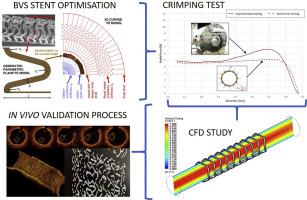当前位置:
X-MOL 学术
›
Mater. Des.
›
论文详情
Our official English website, www.x-mol.net, welcomes your feedback! (Note: you will need to create a separate account there.)
BVS stent optimisation based on a parametric model with a multistage validation process
Materials & Design ( IF 8.4 ) Pub Date : 2021-01-01 , DOI: 10.1016/j.matdes.2020.109363 Łukasz A. Mazurkiewicz , Jakub Bukała , Jerzy Małachowski , Michał Tomaszewski , Piotr P. Buszman
Materials & Design ( IF 8.4 ) Pub Date : 2021-01-01 , DOI: 10.1016/j.matdes.2020.109363 Łukasz A. Mazurkiewicz , Jakub Bukała , Jerzy Małachowski , Michał Tomaszewski , Piotr P. Buszman

|
Abstract Developing new polymer-based bioresorbable vascular scaffolds (BVS) requires a new structural geometry, as these polymer materials are characterised by substantially lower stiffness than metallic alloys. Sufficient radial strength of the stent is essential, as insufficient vessel wall support can lead to a significant recoil (reduction of the vessel lumen) and can cause dangerous complications. To assess the stress development and deformation of the stent, finite element analysis (FEA) was used. First, a complex FEA of the inflation and crimping processes of a bioresorbable coronary stent was performed. An optimisation procedure based on the simplified parametric FE model was subsequently performed to obtain the optimal geometric parameters of the analysed structure. The objective of the optimisation was to maximise the vessel diameter after the BVS implantation. The optimisation procedure was based on automatic model-generating scripts, numerical analyses and implementation of genetic algorithms. Finally, a comparison of the parametric and complex models results was performed, as well as a final validation at several stages (structural studies, computational fluid dynamics (CFD) simulations and in vivo testing). The validation confirmed that the presented optimisation methodology represents a valid and useful tool for the stent design process.
中文翻译:

基于具有多阶段验证过程的参数模型的 BVS 支架优化
摘要 开发新的基于聚合物的生物可吸收血管支架 (BVS) 需要新的结构几何形状,因为这些聚合物材料的刚度比金属合金低得多。支架足够的径向强度是必不可少的,因为血管壁支撑不足会导致显着的回弹(血管腔减少),并可能导致危险的并发症。为了评估支架的应力发展和变形,使用了有限元分析 (FEA)。首先,对生物可吸收冠状动脉支架的膨胀和卷曲过程进行了复杂的 FEA。随后执行基于简化参数有限元模型的优化程序,以获得所分析结构的最佳几何参数。优化的目标是在 BVS 植入后最大化血管直径。优化程序基于自动模型生成脚本、数值分析和遗传算法的实现。最后,对参数模型和复杂模型结果进行了比较,并在几个阶段(结构研究、计算流体动力学 (CFD) 模拟和体内测试)进行了最终验证。验证证实,所提出的优化方法代表了支架设计过程的有效且有用的工具。以及几个阶段的最终验证(结构研究、计算流体动力学 (CFD) 模拟和体内测试)。验证证实,所提出的优化方法代表了支架设计过程的有效且有用的工具。以及几个阶段的最终验证(结构研究、计算流体动力学 (CFD) 模拟和体内测试)。验证确认所提出的优化方法代表了支架设计过程的有效且有用的工具。
更新日期:2021-01-01
中文翻译:

基于具有多阶段验证过程的参数模型的 BVS 支架优化
摘要 开发新的基于聚合物的生物可吸收血管支架 (BVS) 需要新的结构几何形状,因为这些聚合物材料的刚度比金属合金低得多。支架足够的径向强度是必不可少的,因为血管壁支撑不足会导致显着的回弹(血管腔减少),并可能导致危险的并发症。为了评估支架的应力发展和变形,使用了有限元分析 (FEA)。首先,对生物可吸收冠状动脉支架的膨胀和卷曲过程进行了复杂的 FEA。随后执行基于简化参数有限元模型的优化程序,以获得所分析结构的最佳几何参数。优化的目标是在 BVS 植入后最大化血管直径。优化程序基于自动模型生成脚本、数值分析和遗传算法的实现。最后,对参数模型和复杂模型结果进行了比较,并在几个阶段(结构研究、计算流体动力学 (CFD) 模拟和体内测试)进行了最终验证。验证证实,所提出的优化方法代表了支架设计过程的有效且有用的工具。以及几个阶段的最终验证(结构研究、计算流体动力学 (CFD) 模拟和体内测试)。验证证实,所提出的优化方法代表了支架设计过程的有效且有用的工具。以及几个阶段的最终验证(结构研究、计算流体动力学 (CFD) 模拟和体内测试)。验证确认所提出的优化方法代表了支架设计过程的有效且有用的工具。



























 京公网安备 11010802027423号
京公网安备 11010802027423号